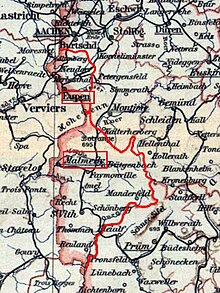Eupen-Malmedy Governorate
| Eupen-Malmedy Governorate | |
|---|---|
| Inventory period | 1920-1925 |
| Affiliation | Independent administrative unit in the Kingdom of Belgium |
| Administrative headquarters | Malmedy |
| Number of municipalities | around 64 |
| surface | |
| Residents | |
| Population density | |
| Rough location of the Eupen-Malmedy governorate in Belgium | |
The Eupen-Malmedy Governorate was a Belgian administrative unit that existed from 1920 to 1925. Its administrative seat was in Malmedy .
The German Reich had in 1919 under the provisions of the Versailles Treaty (Articles 32 to 34) areas in Prussia nearby Rhine Province to the State Belgium cede.
history
In a law passed by the Belgian state on September 15, 1919, the newly acquired area was given a special status. It was not assigned to a province, but as an independent administrative area was subordinated to a High Commissioner, who was also governor. Its activity began according to the provisions of the Versailles Treaty on January 10, 1920. The district assemblies in Eupen and Malmedy were dissolved. Herman Baltia was appointed High Commissioner . He had almost unlimited powers in accordance with the provisions of Articles II and VII of the Act of September 15, 1919. Baltia gradually introduced Belgian legislation in the area often referred to as New Belgium . The governorate was gradually adapted to the Belgian school, legal and economic system. Baltia was also responsible for conducting a non-binding referendum, changes in administration and preparing the eventual annexation of the governorate to Belgian territory.
On March 7, 1925, the Senate decided to abolish the General Government on July 1, 1925 and to fully integrate the area into the Belgian state on September 15, 1925. Thus, the residents of this area received full civil rights.
The previous territory of the governorate was incorporated into the Verviers district.
Assigned territory
On January 10, 1920 the following areas were ceded:
-
District of Eupen with the municipalities
- Eupen , Eynatten , Hauset , Hergenrath , Kettenis , Lontzen , Preußisch Moresnet , Raeren and Walhorn
-
Malmedy district with the municipalities
- Amel , Bellevaux , mountain , Bévercé, Büllingen , Bürnenville, Bütgenbach , Burg Reuland , Deidenberg , Eibertingen , Elsenborn , Faymonville , Geromont, Heppenbach , Herresbach , Honsfeld , Hünningen , Iveldingen , Krinkelt , Krombach , Ligneuville , Lommersweiler , Malmedy , Manderfeld , Medell , Meyerode , Mirfeld , Möderscheid , Montenau , Mürringen , Nidrum , Ovifat , Recht , Robertville , Rocherath , Sankt Vith , Schönberg , Schoppen , Sourbrodt , Thommen , Valender , Wallerode , Weismes , Weywertz , Wirtzfeld and Xhoffraix
- from the Monschau district
- the district of Küchelscheid and the west of the district of Leykaul of the municipality of Kalterherberg
In addition to the territory ceded by Prussia, the previous Neutral-Moresnet condominium was also added to the new governorate, which became the Kelmis municipality .
On March 27, 1920, the border was moved to the east side of the Vennbahn . The following areas came to Belgium:
- from the Monschau district
- the areas of the municipality of Roetgen to the south and west of the Vennbahn
- the areas of the municipality of Lammersdorf to the west of the Vennbahn
- the house Auf Aderich 33 of the municipality of Konzen ( setback )
- the municipality of Mützenich
- the Ruitzhof district of the municipality of Kalterherberg
- from the Prüm district
- the hamlet of Hemmeres in the municipality of Winterspelt
On October 1, 1921, the following area became part of Belgium:
- from the Monschau district
- Parts of the municipality of Kalterherberg
- This is the municipality in the north of the Elsenborn military training area .
Reclassifications
On October 1, 1921, the following areas were returned to the German Reich:
-
District of Eupen :
- Small picture from the Hergenrath community
- Lichtenbusch (partly) from the municipality of Raeren
- Sief from the municipality of Raeren
- Bildchen, Lichtenbusch and Sief were incorporated into the city of Aachen on November 1, 1922 .
-
Malmedy district :
- Kehr (partly) from the community of Manderfeld
- Losheim from the municipality of Manderfeld
- Losheim and Kehr formed the new Losheim community in the Schleiden district on October 1, 1921 .
- from the Monschau district :
- the areas of the municipality of Roetgen to the south and west of the Vennbahn
- the areas of the municipality of Lammersdorf to the west of the Vennbahn
- the house Auf Aderich 33 of the municipality of Konzen
- the municipality of Mützenich
- the Ruitzhof district of the municipality of Kalterherberg
- The area with the railway facilities remained in Belgium.
- from the Prüm district :
- the hamlet of Hemmeres in the municipality of Winterspelt
- The area with the railway facilities remained in Belgium.
